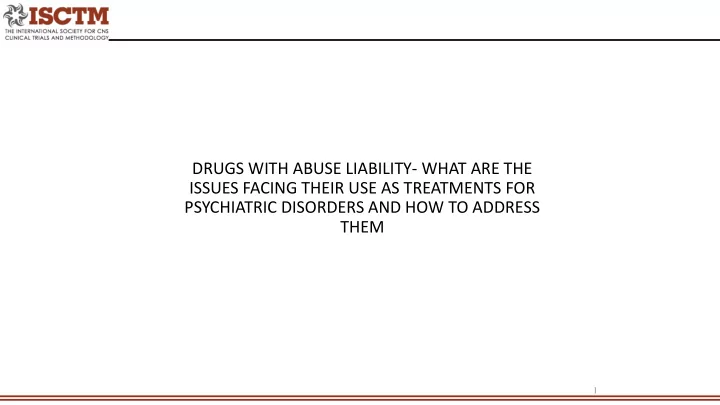

DRUGS WITH ABUSE LIABILITY- WHAT ARE THE ISSUES FACING THEIR USE AS TREATMENTS FOR PSYCHIATRIC DISORDERS AND HOW TO ADDRESS THEM 1
Disclosures • Consulting fees: Dr. Sanacora has received fees from Allergan, Alkermes, AstraZeneca, Avanier Pharmaceuticals, Axsome Therapeutics, Biohaven Pharmaceuticals, Boehringer Ingelheim International GmbH, Bristol-Myers Squibb, Clexio Biosciences, Intra-Cellular Therapies, Janssen, Merck, Naurex, Navitor Pharmaceuticals, Novartis, Noven Pharmaceuticals, Otsuka, Praxis Therapeutics, Sage Pharmaceuticals, Servier Pharmaceuticals, Taisho Pharmaceuticals, Teva, Valeant, and Vistagen therapeutics over the last 36 months. • Research contracts: AstraZeneca, Bristol-Myers Squibb, Eli Lilly & Co., Johnson & Johnson (Janssen), Hoffman La-Roche, Merck & Co., Naurex, Servier, and Usona over the last 5 years. Free medication was provided to Dr. Sanacora for an NIH sponsored study by Sanofi- Aventis. • In addition Dr. Sanacora holds equity in BioHaven Pharmaceuticals and is a co-inventor on a US patent (#8,778,979) held by Yale University and is a co-inventor on U.S. Provisional Patent Application No. 047162-7177P1 (00754) filed on August 20, 2018 by Yale University Office of Cooperative Research OCR 7451 US01 Abdallah, C, Krystal, JH, Duman, R, Sanacora, G. Combination Therapy for Treating or Preventing Depression or Other Mood Diseases. • Yale University has a financial relationship with Janssen Pharmaceuticals, and may in the future receive financial benefits from this relationship. The University has put multiple measures in place to mitigate this institutional conflict of interest. Questions about the details of these measures should be directed to Yale University’s Conflict of Interest office.
Id Identify fying Majo jor Concerns • Public Safety Percentage of the Total Heroin-Dependent Sample That Used Heroin or a Prescription Opioid as Their First Opioid of Abuse • Individual Safety • Scientific Integrity Cicero et al. JAMA Psychiatry. 2014;71(7):821-826 Functional Unblinding
Getting a Better Understanding of f Abuse Potential and The Risks of f Abuse • What are the actual rates of abuse/misuse? • How dangerous is the drug? • Is there evidence of “addiction” A state in which an organism engages in compulsive behavior? • Reinforcing, Pleasurable, Loss of control in limiting intake, Tolerance, Sensitization, Drug seeking behavior • Is there evidence of “Dependence” A state in which the organism functions normally only in the presence of the drug? • Withdrawal • Unknown for ketamine and Psilocybin https://www.drugabuse.gov/drugs-abuse/commonly-abused- drugs-charts#ketamine • Short-term vs Protracted Withdrawal • Neurobiological Mechanisms
Past Year Hallucinogen Use among People Aged 12 Past Month Substance Use among People Aged 12 or Older 2015-2018 or Older 2018 There is no quality data even available on the number of being treated for hallucinogen misuse in the USA http://www.samhsa.gov/data/sites/default/files/cbhsq- reports/NSDUHNationalFindingsReport2018/NSDUHNationalFindingsReport2018.pdf https://www.who.int/medicines/news/20160309_FactFile_Ketamine.pdf
Is Is there Evidence of Tolerance ? • Tolerance to individual components of the drugs’ effects • Perception • Cognition • Antidepressant • Evidence of dose escalation • Evidence of frequency escalation
Proposed Methodological Approaches to In Independently Assess Protracted Withdrawal • Evaluate time courses of symptoms between active treatment and placebo groups • Use of unique challenges • Measures of Craving
Problems associated wit ith Assessin ing for Protracted Wit ithdrawal Symptoms 1. Lack of known neurobiology to assess in preclinical models 2. Non-specific behavioral and physiological effects
What is the Neurobiological Evidence of f Mechanism of Addictive Actions ? The inhibitory constant values for ketamine and • Mu Opioid story with ketamine esketamine binding • N-methyl- D -aspartate receptors (approximately 1 mM and 0.5 mM, respectively [1]). • Human mu opioid receptor (42.1 mM and 28.6 mM, respectively [1,2]). Williams et al. Am J Psychiatry 2018 • The estimated mean unbound levels in the brain are approximately 1 mM for ketamine when administered at the antidepressant dosage of 0.5 mg/kg (1,3) and approximately 0.4 mM for esketamine (administered at 84 mg of nasal spray) (3, 4). 1. Zanos et al. Pharmacol Rev 2018 2. Hirota et al. Anesthesiology 1999 Sanacora Am J Psychiatry 2019 3. Shaffer et al. Neuropharmacology 2014 4. Drevets etl al. Am J Psychiatry 2019 Normal function of the endogenous opioid system may be necessary to permit the expression of the full antidepressant response associated with ketamine. Klein et al. PNAS February 4, 2020 117 (5) 2656-2662
Should we exclude subje jects wit ith his istory ry of f dru rug abuse to any substance, or r his istory ry of f abusing the study dru rug fr from studies, or r li limit treatment availability • What are we really trying to achieve? • What is the evidence that medical prescription of drugs of potential abuse will in fact lead to abuse? Is the risk the same across classes? • Opioids Abstinence across the 21-day post-infusion period among study participants receiving ketamine or midazolam (N=40) • Benzodiazepines • Stimulants • Ketamine • Psilocybin • What are the real-world Consequences? Dakwar et al. Am J Psychiatry. 2020 Feb 1;177(2):125-133
How can we best help ensure the rational and responsible development of f treatments wit ith abuse li liability • Preclinical • Early phase clinical Total Number of Physicians Initiating the Practice of Providing Ketamine Off Label for the Treatment of Psychiatric Disorders per • Late phase clinical Calendar Year (Bars), and Cumulative Number of Ketamine Providers Over Time (Line) Wilkinson et al. Am J Psychiatry . 2017 Jul 1;174(7):695-696 • Post-marketing surveillance McShane et al. Am J Psychiatry 2019
Functional Unblinding Quandary ry • How important is it to manage functional unblinding? • What are we trying to achieve with blinding? • How far do we go in insuring an adequate level of blinding? • What if there is a synergistic interaction with the drugs’ physiological effects and the effects of functional unblinding? • What is the best way of blinding specific drugs • Ketamine/Esketamine • Psilocybin • Benzodiazepines or other GABA targeting drugs
Recommend
More recommend